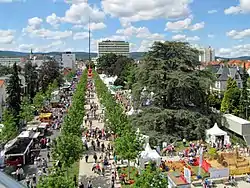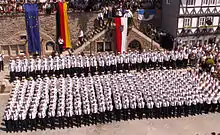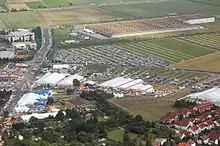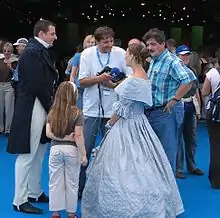Hessentag
The Hessentag (German pronunciation: [ˈhɛsn̩taːk]; English: Hessian Day) is an annual event, both fair and festival, organized by the German state of Hesse to represent the different regions of Hesse. The events are shown for a week to the visitors, with an emphasis on cultural displays and exhibitions. It is the oldest and largest state festival (Landesfest) in Germany.
| Hessentag | |
|---|---|
 Oberursel (Taunus), 2011 | |
| Genre | Fair and festival |
| Date(s) | ten days in June |
| Frequency | annual |
| Location(s) | varies |
| Inaugurated | 1961 |
| Organised by | Hesse |



History
The Hessentag was launched in 1961 by the prime minister of Hesse, Georg August Zinn. The event was intended to bring together long-time residents and migrants and to provide a sense of their new home to the many refugees and displaced persons.[1][2] Hesse itself had to catch up in terms of togetherness; the state was only created in 1945 by a decision of the victorious powers of World War II, from areas with different history and development. Georg August Zinn knew how to integrate the various new "Hessians", following his motto: "Hesse ist, wer Hesse sein will" (A Hessian is anybody who wants to be a Hessian").[1]
The first Hessentag in Alsfeld in 1961 was held on three days, presenting a fair and a parade of the different traditional costumes in Hesse. It attracted 40.000 visitors. Because of this success, an annual event was held.[1] The Hessentag is hosted by a different town each year. The event comes with publicity, improved infrastructure and restoration of historic buildings, but is expensive for the host town.[1][2]
Hessentag has undergone many changes.[2] Originally it was held on one weekend (three days), but grew to a week, including both weekends. It connects Hessian culture, tradition and modern lifestyle. The first focus of the event was presentation of traditions, especially the wide variety of costumes in Hesse and also the costumes of the new citizens who came after 1945. Concerts by international pop groups have become a featured part of the program. The Landesausstellung (State Exhibition) is shown in mobile halls, presenting the state government, the parliament, parliamentary groups, various state agencies and organizations, associations and clubs. Regions of Hesse are presented mostly from a tourist's point of view. Since 1971, for each Hessentag a couple (Hessentagspaar) is elected to represent it. Since 1993, a motto for the event was chosen by the hosting town, also a logo. The event is traditionally closed by a parade.[3]
Each year the event has attracted more than half a million visitors, not only from Hesse. More than one million visitors were counted first in Baunatal in 1999, the leader so far was Kassel, with nearly 1.9 million visitors in 2013. Other towns attracting more than one million visitors were Dietzenbach (2001), Butzbach (2007), Langenselbold (2009), Stadtallendorf (2010) and Oberursel (2011). The Hessentag 2012 was held in Wetzlar[3] and attracted 1.2 million visitors.[4]
In 2020, the scheduled Hessentag in Bad Vilbel was cancelled for the first time due to the COVID-19 pandemic.[5]
Locations
| No. | Year | Location | Visitors | Days |
|---|---|---|---|---|
| 1 | 1961 | Alsfeld | 40,000 | 3 |
| 2 | 1962 | Michelstadt | 40,000 | 3 |
| 3 | 1963 | Hanau | 60,000 | 3 |
| 4 | 1964 | Kassel | 430,000 | 3 |
| 5 | 1965 | Darmstadt | 350,000 | 5 |
| 6 | 1966 | Friedberg | 120,000 | 3 |
| 7 | 1967 | Bad Hersfeld | 150,000 | 3 |
| 8 | 1968 | Viernheim | 150,000 | 3 |
| 9 | 1969 | Gießen | 200,000 | 3 |
| 10 | 1970 | Wiesbaden | 200,000 | 3 |
| 11 | 1971 | Eschwege | 160,000 | 3 |
| 12 | 1972 | Marburg | 250,000 | 9 |
| 13 | 1973 | Pfungstadt | 160,000 | 9 |
| 14 | 1974 | Fritzlar | 230,000 | 9 |
| 15 | 1975 | Wetzlar | 370,000 | 9 |
| 16 | 1976 | Bensheim | 345,000 | 9 |
| 17 | 1977 | Dreieich | 450,000 | 9 |
| 18 | 1978 | Hofgeismar | 300,000 | 9 |
| 19 | 1979 | Friedberg | 350,000 | 9 |
| 20 | 1980 | Grünberg | 275,000 | 9 |
| 21 | 1981 | Bürstadt | 300,000 | 9 |
| 22 | 1982 | Wächtersbach | 300,000 | 8 |
| 23 | 1983 | Lauterbach | 300,000 | 9 |
| 24 | 1984 | Lampertheim | 400,000 | 9 |
| 25 | 1985 | Alsfeld | 400,000 | 9 |
| 26 | 1986 | Herborn | 350,000 | 9 |
| 27 | 1987 | Melsungen | 400,000 | 9 |
| 28 | 1988 | Hofheim | 450,000 | 6 |
| 29 | 1989 | Frankenberg | 480,000 | 9 |
| 30 | 1990 | Fulda | 700,000 | 10 |
| 31 | 1991 | Lorsch | 580,000 | 10 |
| 32 | 1992 | Wolfhagen | 680,000 | 10 |
| 33 | 1993 | Lich | 860,000 | 10 |
| 34 | 1994 | Groß-Gerau | 680,000 | 10 |
| 35 | 1995 | Schwalmstadt | 760,000 | 10 |
| 36 | 1996 | Gelnhausen | 660,000 | 10 |
| 37 | 1997 | Korbach | 700,000 | 10 |
| 38 | 1998 | Erbach | 520,000 | 10 |
| 39 | 1999 | Baunatal | 1,060,000 | 10 |
| 40 | 2000 | Hünfeld | 710,000 | 10 |
| 41 | 2001 | Dietzenbach | 1,100,000 | 10 |
| 42 | 2002 | Idstein | 925,000 | 10 |
| 43 | 2003 | Bad Arolsen | 780,000 | 10 |
| 44 | 2004 | Heppenheim | 915,000 | 10 |
| 45 | 2005 | Weilburg | 840,000 | 10 |
| 46 | 2006 | Hessisch Lichtenau | 580,000 | 10 |
| 47 | 2007 | Butzbach | 1,100,000 | 10 |
| 48 | 2008 | Homberg (Efze) | 810,000 | 10 |
| 49 | 2009 | Langenselbold | 1,000,000 | 10 |
| 50 | 2010 | Stadtallendorf | 1,100,000 | 10 |
| 51 | 2011 | Oberursel (Taunus) | 1,400,000 | 10 |
| 52 | 2012 | Wetzlar | 1,215,000 | 10 |
| 53 | 2013 | Kassel | 1,830,000 | 10 |
| 54 | 2014 | Bensheim | 1,325,000 | 10 |
| 55 | 2015 | Hofgeismar | 750,000 | 10 |
| 56 | 2016 | Herborn | 940,000[6] | 10 |
| 57 | 2017 | Rüsselsheim | 1.400.000 | 10 |
| 58 | 2018 | Korbach | 845.000 | 10 |
| 59 | 2019 | Bad Hersfeld | 862.000[7] | 10 |
Planned locations
| No. | Year | Location |
|---|---|---|
| 60 | 2020 | Bad Vilbel - cancelled due to COVID-19 pandemic[5] |
| 61 | 2021 | Fulda[8] |
| 62 | 2022 | Haiger[9] |
| 63 | 2023 | Pfungstadt[10] |
References
- Maximilian Kutzner. "Die Geschichte des Hessentags" (in German). Universität Gießen. Retrieved 15 June 2012.
- "Die Geschichte des Hessentages" (in German). Hesse. Retrieved 15 June 2012.
- "Wetzlar macht sich bereit: Hessentag: 1.000 Events in zehn Tagen" (in German). Hessischer Rundfunk. Archived from the original on 8 September 2012. Retrieved 18 May 2012.
- "Hessentag endet mit Traditionen und Trachten – 1,2 Millionen Besucher" (in German). echo-online.de. 10 June 2012. Retrieved 14 June 2012.
- "Stadt Bad Vilbel und Land Hessen sagen Hessentag 2020 ab" (in German). hessentag2020.de. 2020-03-19. Retrieved 2020-04-16.
- "Hessentag in Herborn" (in German). hessentag2016.de. 2016. Retrieved 14 June 2016.
- "862.000 Besucher feiern den Hessentag" (in German). hessentag2019.de. 2019. Retrieved 3 December 2019.
- "Fulda richtet Hessentag 2021 aus". hessenschau.de (in German). Archived from the original on 2018-02-28. Retrieved 2018-02-27.
- "Der Hessentag 2022 steigt in Haiger". hessenschau.de (in German). Archived from the original on 2018-03-20. Retrieved 2018-03-20.
- "Pfungstadt richtet Hessentag aus". hessenschau.de (in German). Retrieved 2019-12-03.
External links
| Wikimedia Commons has media related to Hessentag. |
- Ministerpräsident Volker Bouffier: „Tradition des Hessentags mit Herzlichkeit und Offenheit gelebt“ (Prime Minister Volker Bouffier: "Tradition of Hessentags lived with friendliness and openness"), press release of Hessische Staatskanzlei, 10 June 2012 (in German)
- 250.000 Besucher auf hr-Veranstaltungen Hessischer Rundfunk (in German)
- Hessentag 2012 in Wetzlar Frankfurter Rundschau (in German)
- Von guten Stuten und feinen Schweinen FAZ 8 June 2012 (in German)
- Fast eine halbe Million Besucher bei Hessentag Faz 6 June 2012 (in German)